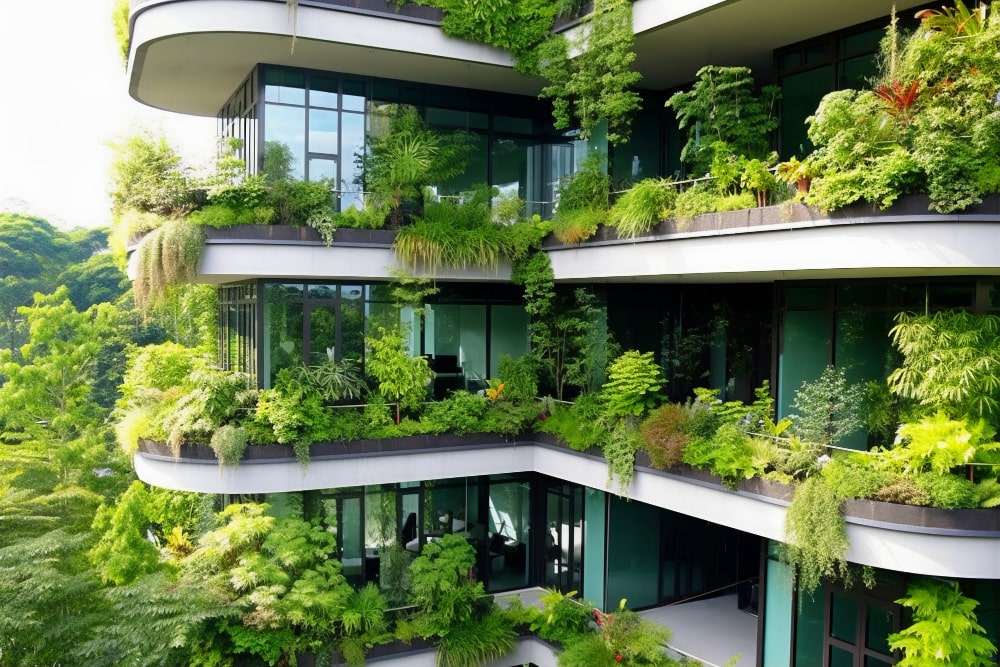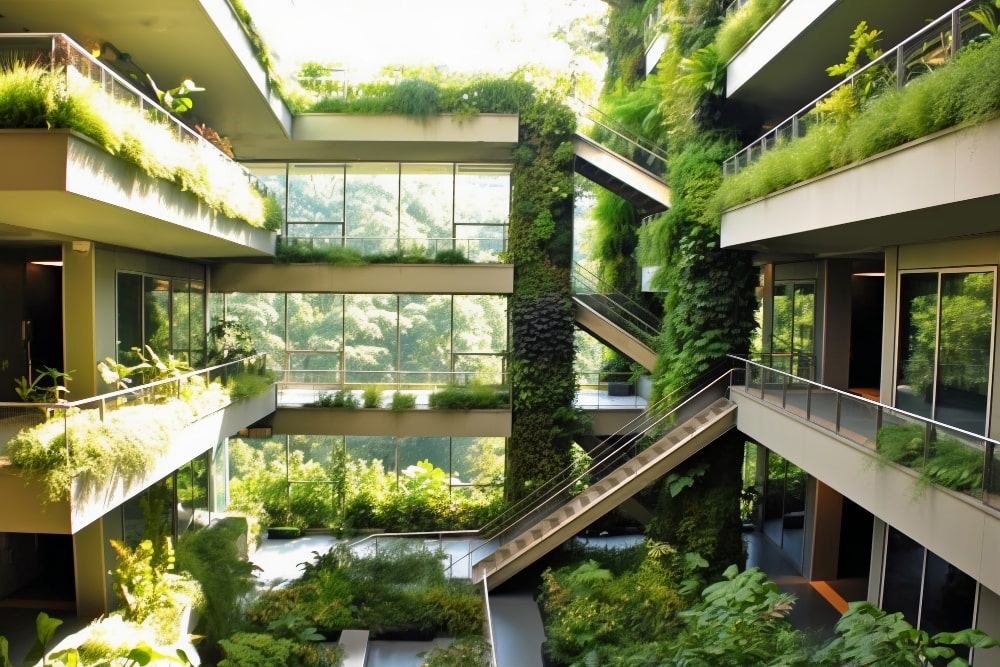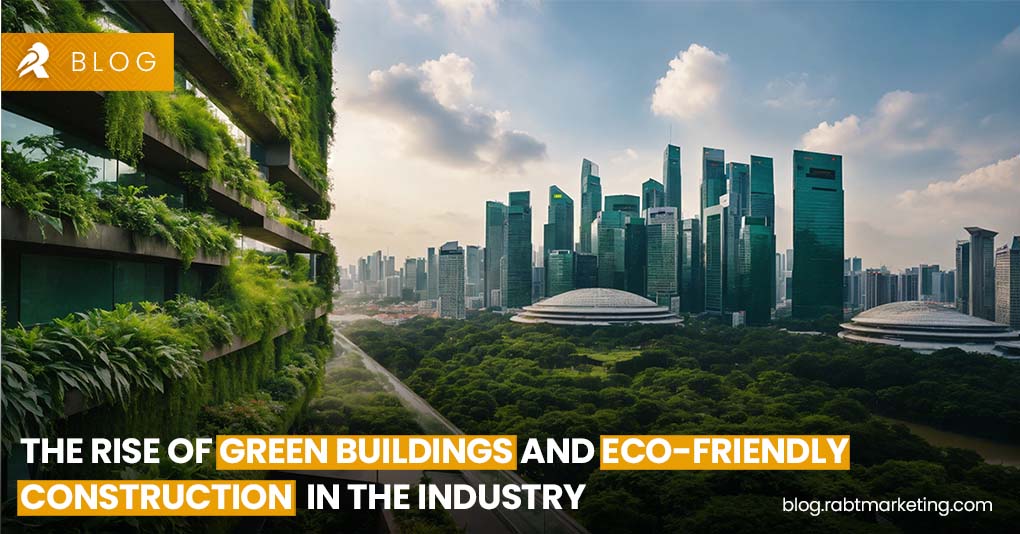The construction industry has long been characterized by its heavy machinery, towering structures, and, unfortunately, its significant environmental footprint. However, a revolution is underway, with eco-friendly construction methods and green buildings changing the landscape. These sustainable practices aren’t just fleeting trends; they signal a fundamental transformation as we think globally and build locally with an eye on environmental impact.
The Emergence of Green Buildings Trends

The Construction Industry is continuously evolving. Sustainable architecture has gone from niche to necessary, and several key trends are at the basic part of this evolution:
Energy Efficiency: The modern green building is designed to consume less energy, with features like improved insulation, energy-efficient HVAC systems, and windows that minimize heat loss.
Renewable Energy: Solar panels, wind turbines, and other renewable energy sources are becoming common in new constructions, significantly reducing the reliance on fossil fuels.
Water Conservation: Systems for rainwater harvesting, greywater recycling, and low-flow fixtures are being implemented to conserve water resources.
Sustainable Materials: There’s a move towards materials that are recycled, renewable, or have low environmental impact, such as bamboo flooring, recycled steel, and low-VOC paints.
Green Roofing and Walls: These living installations of plants not only insulate buildings but also support biodiversity and manage rainwater more effectively.
Smart Technology: IoT devices and smart systems help buildings to operationally reduce waste by optimizing energy and water use.
The Benefits of Going Green

The advantages of green building practices extend well beyond just environmental benefits. Economically, they often result in reduced operating costs, better ROI, and higher property values. Socially, they contribute to improved occupant health and comfort. Here are some of the key benefits of green construction:
Reduced environmental impact: Green buildings use less energy and water, conserve natural resources, and create less pollution. This helps to combat climate change and protect the environment for future generations.
Improved occupant health: Green buildings are designed to provide a healthy and comfortable indoor environment for occupants. This can lead to improved productivity, fewer sick days, and a better overall quality of life.
Lower operating costs: Green buildings are often more energy-efficient, which can lead to significant savings on utility bills. They may also use less water and other resources, which can further reduce operating costs.
Increased property value: Living buildings have become famous with tenants and buyers. So their rents are higher and their property value is increased.
Conservation of natural resources: Green construction techniques often involve using recycled or reclaimed materials, which helps to conserve natural resources. Additionally, green buildings may be designed to use less water for irrigation and other purposes.
Challenges
Despite the clear benefits, the shift towards sustainable building has its challenges. Initial costs can be higher, and a learning curve is associated with new materials and technologies. Education and advocacy are vital in the implementation of green construction.
Moreover, 3D printing is a also an emerging construction technology. If you are interested to read about this technology, click here.
Now, let’s address some common questions related to green buildings and eco-friendly construction:
FAQ’s
1. What makes a building “green”?
Ans. A “green” building is designed, built, and operated to reduce or eliminate negative impacts on the environment and its occupants. This encompasses energy efficiency, the use of sustainable materials, and the overall carbon footprint of the structure.
2. Are eco-friendly buildings more expensive to construct?
Ans. Initially, the cost can be higher due to the price of sustainable materials and the investment in energy-efficient systems. However, the reductions in operating costs often offset this initial investment over time.
3. How does green construction impact health?
Ans. Green buildings often have better air quality and natural lighting and use materials that emit fewer toxins, which can lead to healthier environments for occupants.
4. Can existing buildings be made eco-friendly?
Ans. Absolutely. Retrofitting older buildings with energy-efficient systems, better insulation, and eco-friendly materials is a growing trend within the industry.
5. Are there certifications for green buildings?
Ans. Yes, certifications such as LEED (Leadership in Energy and Environmental Design), BREEAM (Building Research Establishment Environmental Assessment Method), and others provide guidelines and frameworks for constructing green buildings.
6. What is the future of eco-friendly construction?
Ans. The future looks bright as technology advances, regulatory bodies tighten standards, and public demand for sustainable living spaces grows. Eco-friendly construction is expected to become the standard in the building industry.
Final Words
In this era of technology and artificial intelligence, every industry and profession is changing rapidly. Nature is a pure blessing from the creator of the Universe, Allah Almighty. Living buildings are a very beautiful concept that enables society to benefit from nature. More and more, builders are focussed on eco-friendly practices because they’re good for the environment and make practical sense.
As people become more aware and technology gets better, we’re aiming for a future where every community cares about sustainability. It’s a big change. We’re all working together to make sure our homes, offices, and public places fit in with nature.

